Ernest Hemingway, Mexican Baseball, German Submarines & Ava Gardner's Knickers
Saturday, November 08, 2008
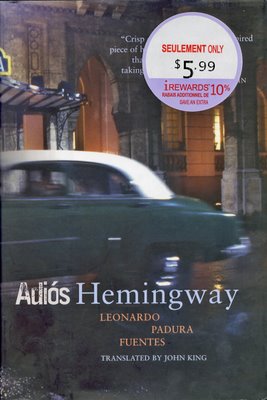 On February 1, 1946, my own Season of gold began as I, Frank Bullinger, Jr. arrived at the front door of La Finca Vigía, expecting to be Hemingway’s only guest, clutching in both hands the manuscript of my novel. Suddenly, several charming famous men with guns plus two wary-looking women, also with guns, came bounding down the front steps, drunk and dressed in peacoats and flannel, leather patches in the right places. Me, I wasn’t drunk, struggled to be charming, and never would become famous. I was a slight man, drenched from the storm that hit the Cuba Line on my way from Miami, dressed in a blus sport coat and a tie I’d gotten for Father’s Day. Gene Tunney brushed past me, portrait of the working-class hero turned patrician millionaire. Babe Ruth patted me on the head and said “Hiya, kid.” On February 1, 1946, my own Season of gold began as I, Frank Bullinger, Jr. arrived at the front door of La Finca Vigía, expecting to be Hemingway’s only guest, clutching in both hands the manuscript of my novel. Suddenly, several charming famous men with guns plus two wary-looking women, also with guns, came bounding down the front steps, drunk and dressed in peacoats and flannel, leather patches in the right places. Me, I wasn’t drunk, struggled to be charming, and never would become famous. I was a slight man, drenched from the storm that hit the Cuba Line on my way from Miami, dressed in a blus sport coat and a tie I’d gotten for Father’s Day. Gene Tunney brushed past me, portrait of the working-class hero turned patrician millionaire. Babe Ruth patted me on the head and said “Hiya, kid.”
The Veracruz Blues, Mark Winegardner, Viking 1996
This talk of the Veracruzanos reminds me of a famous Mexican joke. A woman comes into a produce market and asks to buy half a melon. We don’t sell that way, says the clerk. You must buy the whole melon. I don’t want the whole melon, the woman says. She gets more obstreperous about the matter and finally the clerk reluctantly agrees to go speak to the owner.
“Can you believe it?” he says to the owner in the back office. “A cheap hag bitch wants to buy half a melon.” The clerk sees alarm in the owner’s eyes and turns around. The woman is right behind him. “And this charming lady,” he quickly says, “wishes to buy the other half.”
The sale is consummated, the woman happily carts away her half melon, and the owner impressed by the young clerk’s quick mind, mentions that he is opening a new produce market in Veracruz. Someone so sharp-witted might be just the person to manage that market, no?
But the clerk is aghast. “Veracruz!” he says. “What a hellhole! There’s nothing in Veracruz but whores and ballplayers.” The owner frowns; he is furious. “I’ll have you know that my dear wife comes from Veracruz.” “Is that so?” says the clerk, not missing a beat. “Does she bat right-handed or left? “
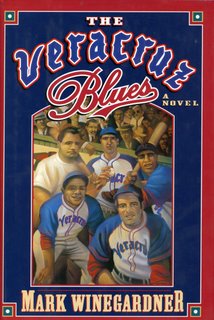
All you wish to know about Mexico, Frank, about our masks, our sense of humor, and the weaponry of our wits, about the way Mexican men see Mexican women, about the Mexican League and my poor dead Jorge, is all contained in that joke.
The Veracruz Blues, Mark Winegardner, Viking 1996When I first read Mark Winegardner’s lovely novel The Veracruz Blues which is a story of the so-called raid on Major League Baseball by the Mexican League in 1946 I became homesick to my own experience in having discovered baseball, a sport I was ignorant about since I had arrived to Mexico from a soccer-crazed Buenos Aires in 1952. A few years later my cousin Robby took me to see a game between the Mexico City Diablos Rojos and the Tigres. I found the experience so exhilarating that I went to other games including ones with the Águila de Veracruz, formerly the Veracruz Blues of Winegardner’s novel. Many years later between 1965 and 1967 when my mother was living in Veracruz I went to see the Águila play in Veracruz in a stadium where I could smell the humid salt air of the port. Since I had lived in Mexico City’s thin air for so many years the sound of the cracking bats at sea level were a new and wonderful experience. In Veracruz Blues I became curious about all the truth and lore of Hemingway’s Cuban period. I read of his fondness for drinking at La Floridita and of his life at his Havana house, la Finca Vigía. It was in Paco Ignacio Taibo II’s Retornamos Como Sombras (We Return as Shadows, but to my knowledge this novel has never been translated into English) that I first disocovered that Hemingway had volunteered in 1942 to look for marauding German submarines in his yacht El Pilar. What was true and what was false in Taibo’s plot.?  1941. While Mexico is about to declare war on Germany, Hitler is injecting himself with Mexican caffeine and becomes addicted to peyote to resist the pressures of the Eastern Front. In the middle of the Chiapanecan forest (in Mexico) a group of brown-shirted Germans march to the tune of an old gramophone and is accosted by a persistent youth who wants to do them in. A poet, recruited as a spy, discovers that the Mexican Minister of the Interior has a lover who works for the Abwehr IV. A few German submarines cruise the Mexican coastline for a place where a final push to attack the American giant could be unleashed. Hemingway in one more of his alcoholic/literary crisis falls asleep in a Havana swimming pool and re-appears with no explanation in Mexico City. 1941. While Mexico is about to declare war on Germany, Hitler is injecting himself with Mexican caffeine and becomes addicted to peyote to resist the pressures of the Eastern Front. In the middle of the Chiapanecan forest (in Mexico) a group of brown-shirted Germans march to the tune of an old gramophone and is accosted by a persistent youth who wants to do them in. A poet, recruited as a spy, discovers that the Mexican Minister of the Interior has a lover who works for the Abwehr IV. A few German submarines cruise the Mexican coastline for a place where a final push to attack the American giant could be unleashed. Hemingway in one more of his alcoholic/literary crisis falls asleep in a Havana swimming pool and re-appears with no explanation in Mexico City. The great Mexican actress María Felix is a protagonist in both Winegardner’s and Taibo’s novel. While I had known that Felix had been the mistress of Mexican president Miguel Alemán I had been unaware of Felix’s affairs with both Diego Rivera and Frida Kahlo. I discovered this in Taibo’s account. Only recently I finished a delightful novel translated from the Spanish written by Cuban writer Leonardo Padura Fuentes. This ingenious murder mystery has Hemingway as a protagonist and the novel shifts back and forth when a body is found buried in Hemingway's La Finca Vigía which is now a lovingly restored museum in Havana. The investigator of the murder (the body is from Hemingway's period and an FBI badge is found nearby) is a retired policeman who is attempting to be a writer and finds Hemingway as inspiration having seen him at a dock by his yacht as a boy. The book is lovely even translated into English and the famous swimming pool of Taibo's novels here plays an important part, too. Our investigator falls asleep on Hemingway's bed and has a stupendous wet dream! The dream has all to do with a pair of black lace nickers that are introduced here where the caretaker/curator of Hemingway's villa asks Conde, the investigator if he had been at the finca before. 'But you didn't see the weapons.'
'No. They're in the tower, aren't they?'
'Yes. And I bet you didn't see Ava Gardener's knickers, either."
Conde felt a pang.
'Whose knickers?'
'Ava Gardner's.'
"You sure about them?'
'Couldn't be surer.'
'No I didn't see them. But I've got to see them. The nearest thing to seeing a woman naked is seeing her underwear. I must see them. What color are they?'
'Black, with lace. Hemingway used them to wrap around his .22 revolver." And the dream begins like this: He saw her when she was already on the edge of the swimming-pool. She was wearing a fresh flowery bath-robe and her hair was loose, falling around her shoulders. He thought her hair seemed lighter than he remembered and he once more enjoyed the perfect beauty of her face. She said something he couldn't hear or didn't understand, perhaps on account of the noise that his own arms were making in the water. He moved them so as not to sink, and they felt heavy and almost not part of him. Then she took off her bathrobe. She wasn't wearing a swimsuit underneath, just a bra and pair of knickers, black ones, made of revealing lace. The cups of the bra were provocative and he could see, through the lace, the pink aureole of her nipples.The above passage proceeds in the kind of stuff that I used to read by sneaking into my mother's Frank G Slaughter novels which had passages the taught me what sex was all about in that distant pre-internet era of my youth. Such was my pleasure in reading Adiós Hemingway that I proceded to Sophia Books to see if they had anything else by Leonardo Padura Fuentes and preferably in Spanish. They did. It was a new edition of Padura Fuentes's first novel Fiebre de Caballos (Horse Fever, but again not translated into English. This is about a boy (a baseball prodigy, too) in his late teens who has yet to have his first introduction to sex. Because it happens with an older woman the novel is like the film The Graduate set in a Fidel Castro envirionment of his revolutionary Cuba. Of baseball Leonardo Pardura Fuentes says: I am a typical Cuban of my generation. I was born in ‘55, so I’ve passed my whole conscious lifetime under the system of the Revolution. I was born and grew up (and still live) in a working-class neighborhood on the outskirts of Havana, where I lived with great freedom, dedicating the majority of my time to that which is still my greatest passion: baseball. Since I’m a lefthander, I played first base and outfield, but I didn’t have enough strength at bat to be a good hitter. And for that reason, when I finished high school I decided to study liberal arts at the University, and shortly thereafter, I figured that if I would not be a baseball player, I would be a writer...But even now, when I see a good game of baseball I think that I would have liked even better to be a great baseball player like el Duque Hernandez, for example: a man whom I admire for his passion and discipline, which in some way resemble what I have when I create literature.  The circle of baseball, Hemingway, Cuba, Maria Felix, Ava Gardener's knickers, German submarines closes around one of my favourite authors, the not too well known American Jerome Charyn. Charyn writes about baseball in his novels, in particular of the New York Giants and the Brooklyn Dodgers. But the circle really closes here because Padura Fuentes cites Jerome Charyn and Alejo Carpentier as two of his favourite authors. Some years ago when I interviewed Paco Ignacio Taibo II I had yet to find the connection between Alejo Carpentier and Taibo's abrupt finish to our interview and Beethoven's Ninth Symphony!
A Win By A Nose
Friday, November 07, 2008
 Tonight Rebecca and I had a feast at Opera Sushi and watched the end of La Traviata on a TV monitor from Convent Garden directed by Sir Georg Solti and sung by Frank Lopardo and Angela Gheorghiu. We picked up our tickets for Cyrano de Bergerac at the Stanley. We were early so we went to a nearby Starbucks. Rebecca had a large cookie which she did not finish. As we entered the Stanley the woman at the door indicated we could not enter with outside food. I convinced her that my 11-year-old granddaughter was going to rapidly finish it inside. Another woman made the couple who were sitting by our side leave. They were munching on what looked like excellent ham and sprout sandwiches. I explained to Rebecca that running a theatre company is expensive and that the in-house bar could not make ends meet if people brought in food and drink. I asked the floor manager if we could visit Carmen Aguirre, backstage, after the end of the play. "My granddaughter has a wish to see what it's like back stage," I told him. He answered unequivically that this was impossible and that we should wait at the lobby. This we did. Carmen Aguirre came out and greeted us. Rebecca told her how she had enjoyed the play. As we left Rebecca said, "Isn't she pretty? Tell me again about Carmen and Isabel Allende and how you asked her to close her eyes when you photographed her with Isabel Allende"  In spite of the cookie police and in spite of a man who simply could not understand how wonderful it would have been for a young girl (the only one there tonight) to meet, backstage, a nun and a man with a long nose, Rebecca told me, "I love the theatre."
Harry Connick Jr. Didn't Tackle Lush Life
Thursday, November 06, 2008
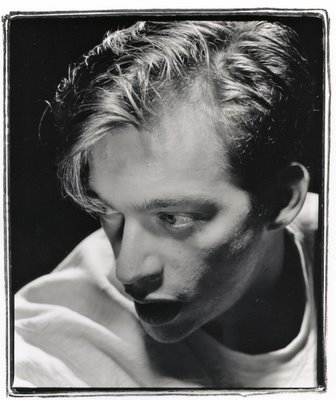 It was October 23, 1990. CBS Records was being taken over by Sony Music. Dave Chesney, the local CBS record rep, had been instructed to find a photographer to record Harry Connick Jr's concert the next day at the Orpheum (a somewhat smaller show than the GM Place performace slated for Fiday night) for Tokyo journalists working on a story on the new Sony star. Fumiko, the Sony representative, was surprised when Dave and I showed up at the Century Plaza Hotel to meet the Japanese Sony delegation. She was concerned that I wasn't Japanese. "Is there anything I can do for you for the trouble?" she asked. I didn't get the job, but Chesney was still keen to have a photo of Harry to accompany one I had taken of Leonard Cohen that graced the CBS office he was soon to depart. At 11 a.m. next morning, we knocked on the door of Harry's room at the Georgian Court Hotel. He was being interviewed by a journalist with the help of a translator. The Japanese photographer who had been flown in from Los Angeles, was taking snaps with his motor-driven Nikon. As soon as I unpacked the lights and set up the medium-format camera on a heavy tripod, the journalist and the photographer made a quick and apologetic exit. We were alone with Harry. Unshaven, he looked uncomfortable. To break the ice I asked Harry if he would ever record my favourite jazz standard, Billy Strayhorn's Lush Life. "That's a woman's song. I don't think I'll tackle it yet." Now smiling and relaxed, however, he added, "I'm ready."
Alvin Balkind Awards & A Rear View Of The Belkin Gallery At UBC
Wednesday, November 05, 2008
 As I write this it is almost 6PM. In an hour Rosemary and I will be at the Helen and Morris Belkin Gallery at the University of British Columbia. We have been invited to the presentation of the establishment of the Alvin Balkind Awards for Creative Curatorship In British Columbia Arts. The award has been funded by Abraham Jedidiah Rogatnick and the first recipients are Scott Watson (curator of the Belkin Gallery) and the Faculty of Arts of the University of British Columbia. I knew I had at least one photograph of the gallery. It is my favourite view of it even though it is the rear view. I took the picture and many others at UBC for an April article for the Georgia Straight on the new architecture at UBC. The article was written by Sean Rossiter. Rossiter's interests have shifted a bit towards aviation and the Straight, after the editorship of Charles Campbell, seems to have lost interest in architecture. I no longer take this sort of picture and with no Rossiter articles on our city architecture we are all that much poorer.  I cannot recall exactly where I took the second photograph. It is not of the Belkin Gallery but it is my favourite picture of all the ones I took that April 1997 at UBC. This blog is my little tribute to architect Abraham Rogatnick for his generosity towards UBC.
Autumnus & The Little Red Shoes
Tuesday, November 04, 2008
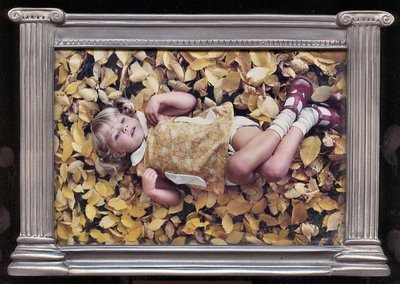 While watching the US elections on CNN tonight I told Rosemary, "I have to write and post today's blog! What am I going to do?" Looking up at the mantle in our TV room (formerly the smoking room) I spotted the picture of Hilary that I took in Vancouver a year after we arrived in 1975. It was fall of 1976 and we had gone to the UBC campus not far from Nitobe Garden. After many years of having lived in Mexico (a rainy season and a dry season) I was not prepared, nor have I ever gotten used to the surprise and beauty of four distinct seasons. Since that 1976, every fall in Vancouver has been a fall to savour and enjoy. This year in particular when I made a call to the Cooks a few days ago, Barbara said, "Isn't this particular autumn glorious? All the right things that could occur to make leaves get more colour have happened." Barbara was nicely recovering from a broken jaw (quite a problem if you are over 80) and her lovely New Zealand accent was back exactly as I remembered. And Monday night when Hilary sat at our table and said, "I am going to be 38 in December," I could not believe that so many years had passed. It seemed that it was not too long ago that I posed her with her little red shoes and she volunteered to cross her legs so cutely. My mother often told me that I would never understand the love of a mother for her son because I would never be a mother. She repeated this so often that I began to feel like I would never achieve a completion of who I was because a segment, called maternal love, would always be empty. She explained that a mother's love was automatic and it did not depend on a mother particularly liking her son. As a matter of fact I was 21 when she confessed to me that she had always loved me as her son but had felt no particular fondness for me. "I did not like you. You were not the kind of son a mother would like." My shock at listening to this was tempered when she added, "But you have somehow changed and I can assert that I now like you." With my mother gone I cannot contribute to our conversation. She had a daughter, my sister, that was born dead so she never had any idea what it was to have a daughter. I have two daughters. But she did have a little glimpse when she attempted to educate our headstrong daughter Ale when Ale was 4. My mother did live long enough to hold Hilary in her arms. Before she met Ale, my mother had been living in North Carolina. She understood the pleasure of dressing up a little girl. She sent us a little dress for Ale that she had purchased at Marshall Field's. For the two years that she lived with us she dressed up Ale in the morning. My mother and I never shared this enjoyment. Rosemary and I were too busy making ends meet. Now as I look at that picture of Hilary at UBC in her bed of fall leaves I have a feeling that I would want to share with my departed mother, "Mother you will never understand what it is to be a father and to love a daughter. You will never be a father."
DeHavilland Beavers - Frank Lloyd Wright - The Perfect Day
Monday, November 03, 2008
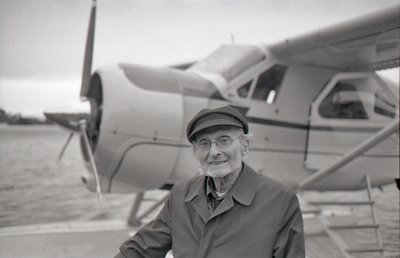 Yesterday I woke up at 5AM and felt terrible. I had slept very little. Yesterday was a perfect day. Abraham Rogatnick picked me up in a cab at 6:10AM and we went to the Vancouver Airport Seaplane Terminal. It was pouring. Abraham is no different to me. This meant that we arrived one hour before our Seair DeHavilland Beaver would take us on our 20 minute flight to Pender Island. We were going to visit Abraham's friend of 50 years, Karl Stittgen and his wife Nora. Stitgen was a renowned Vancouver jeweler for many years. Before he retired he was already dabbling with architecture. Stittgen's hero is architect Frank Lloyd Wright and the house he designed and built on Pender Island is a church to wright. It is as if Wright somehow alive, designed and built the house. Everything about the house (and a new guest house), the furniture, the lamps and even some of the dishware pay homage to the great American architect. In Stittgen's library there is an extensive collections of books and magazines on the man. We were greated at the door by Stittgen and his dog Miho (Nora had picked us up at the dock). I simply did not know where to rest my eyes as everything was a delight. Stittgen the jeweler is now a potter and an amateur (in the 19th century English meaning of the word) architect. The kitchen from where I could smell the large and thin (just the way I like them) pancakes was as perfect as a kitchen could be. We were served breakfast and I had fresh strawberries and fried bananas with my pancakes. The rest of the day was like that. Lunch was accompanied by a very sweet and light German wine from the area in Germany where Stittgen was born. By the time the Stittgens took us back to the dock at 4 I felt that the day had simply been too short. The sun had appeared as soon as we had arrived to Halcyon Days, the name of Stittgen's home. We explored the guest house, the potting shed and as soon as we had returned for lunch the sky opened up again. But not for long. The sun shone again at the dock and as we flew in our Beaver a setting sun waited for us as we skimmed and then landed, ever so placidly, on one of the Fraser River arms.  The perfection of the day was enhanced because of pleasant experience with Seair Seaplanes. The 1950 Beaver that took us to Pender Island had been refurbished and modernized a week before. The paint shone. I explained to Abraham who is an expert on his favourite city of Venice that flying in a Beaver over the waters of British Columbia did not in any way seem any less glorious than being on a gondola on the Grand Canal. Abraham had probably flown in a Beaver before but I explained all I had learned from Sean Rossiter about the Beaver. He suddenly had a new respect for our airplane and enjoyed his flight. Coming back our Beaver was not as pristine but it had some of the original and beautiful wood trim. Both pilots had read Sean Rossiter and were most impressed to find out that both of us were his friends.  The whole day reminded me of my experience taking still photographs for the CBC series Ritter's Cove. Somehow, thanks to Abraham Rogatnick, Nora and Karl Stittgen (their dog Miho) and the beautiful DeHavilland Beavers, those treasured halcyon days of my past had come back, for one perfect day. More Beavers
Siouxsie Sioux - Goth Banshee
Sunday, November 02, 2008
When Vancouver Magazine rock writer Les Wiseman and I met up with Siouxie Sioux at the Sandman Inn on a rainy, early October afternoon I did not have a clue who she was or what kind of music she sang with her band the Banshees. All I knew was that she was English and was avant garde. I had purchased her just released Juju and the music, particularly Spellbound pushed me into greater depression than my then favourite album for achieving the same feeling, Miles Davis' Kind Of Blue.
At the time I was in my sort of minimalist rock photography style. I took a roll of used seamless paper and I would masking-tape it to a hotel room wall. I had just discovered that by carefully using my Pentax 20mm wide angle I could make my pictures look almost as if I had not used such an extreme wide angle. The point of using the wide angle is that it forced me to get close (and intimate) to my subjects. Of the interview these words by Les Wiseman I have always remembered fondly:
"So how about all this mysticism and occult stuf on your new album [Juju]? I heard myself asking a few minutes after tuning on the tape recorder. Thus far the interview had been like trying to reach a mayonnaise lid that has slipped under the frige. Siouxie looked bayfully sweet in oversized trousers prevented from falling right off by a pair of old braces, and a blousy pullover shirt appliquéd with a snarling leopard, her hair a jet elfin hat skyrocketing from her skull. Travel-weary and over-interviewed, she lay propped up on the bed, drinking vodka and smoking like some Twilight Zone Garbo."
It is only recently that I have found out that Siouxsie was really one of the biggest influences on the goth movement. I went to her concert that evening and I was mesmerized by her singing as she droned and shifted from side to side while wearing the tiniest of mini skirts over a pair of beautiful legs in fishnets.
Or as Les Wiseman described it:
Then, bounding and writhing to center stage, Cleopatra-eyed, her hair freaked froth rising from a blur of body language stolen from a Haitian dervish, Siouxsie appears a gorgous vison of rock'n'roll energy in high leather boots, miniskirt and fishnet stockings. The ways that she moves make Mick Jagger and Peter Wolf look as though their shorts are starched with fiberglass. "Oh severed head/I'll feed your head with bread/and paint you lips bright red/I'll keep it fresh on ice/it will look very nice." She chants, incants, moans, shrieks, commands. "And don't forget/when your elders forget/to say their prayers/ take them by the legs/ and throw them down the stairs."
|





















